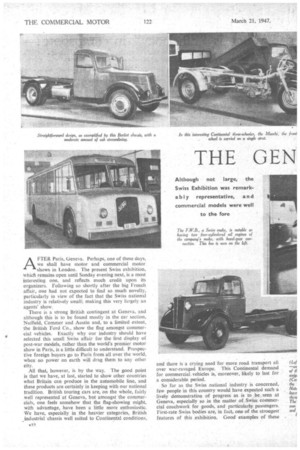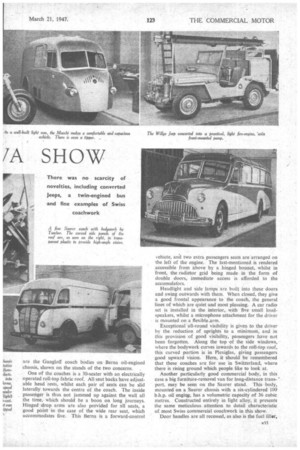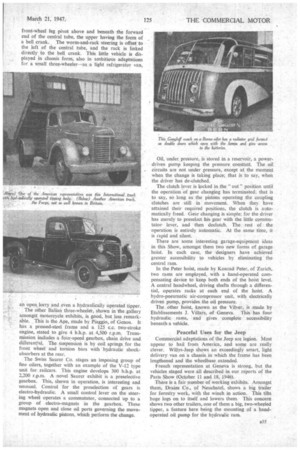THE GEN TA SHOW
Page 38

Page 39

Page 40

Page 41

If you've noticed an error in this article please click here to report it so we can fix it.
AFTER Paris, Geneva. Perhaps, one of these days, we shall have motor and commercial motor shows in London_ The present Swiss exhibition, which remains open until Sunday evening next, is a most interesting one, and reflects much credit upon its organizers. Following so shortly after the big French affair, one had not expected to find so much novelty, particularly in view of the fact that the Swiss national industry is relatively small; making this very largely an agents' show.
There is a strong British contingent at Geneva. and although this is to be found mostly in the car section. Nuffield, Cornmer and Austin and, to a limited extent, the British Ford Co., show the flag amongst commercial vehicles. Exactly why our industry should have selected this small Swiss affair for the first display of post-war models, rather than the world's premier motor show in Paris, is a little difficult to understand. Prospective foreign buyers go to Paris from all over the world, when no power on earth will drag them to any other city.
All that, however, is by the way. The good point is that we have, at last, started to show other countries what Britain can produce in the automobile line, and these products are certainty in keeping with our national tradition. British touring cars are, on the whole, fairly well represented at Geneva, but amongst the commercials, one feels somehow that the flag-showing might, with advantage, have been a little more enthusiastic. We have, especially in the heavier categories, British .industrial chassis well suited to Continental conditions, n17 and there is a crying need for more road transport all over war-ravaged Europe. This Continental demand for commercial. vehicles is, moreover, likely to last for a considerable period.
So far as the Swiss national industry is concerned, few people in this country would have expected such a• lively demonstration of progress as is to be seen at Geneva, especially so in the matter of Swiss commercial coachwork for goods, and particularly, passengers. First-rate Swiss bodies are, in fact, one of the strongest features of this .exhibition. Good examples of these are the Gangloff coach bodies on Berna oil-engined chassis, shown on the stands of the two concerns. .
One of the coaches is a 30-seater with an electrically operated roll-top fabric roof. All seat backs have adjustable head 'rests, whilst each pair of seats can be slid laterally towards the centre of the coach. The inside passenger is thus not jammed up against the wait all the time, which should be a boon on long journeys. Hinged drop arms are also provided for all seats, a good point in the case of the wide rear seat, which accommodates five. This Berna is a forward-control vehicle, aria two extra passengers seats are arranged on the left of the engine. The last-mentioned is rendered accessible from above by a hinged bonnet, whilst in front, the radiator grid being made in the form of double doors, immediate access is afforded to the accumulators.
Headlight and side lamps are built into these doors and swing outwards with them. When closed, they give a good frontal appearance to the coach, the general lines of which are quiet and most pleasing. A car radio set is installed in the interior, with five small loudspeakers, whilst a microphone attachment for the driver is mounted on a flexible arm.
Exceptional all-round visibility is given to the driver by the reduction of uprights to a minimum, and in this provision of good visibility, passengers have not been forgotten. Along the top -of the side windows, where the bodywork curves inwards to the roll-top roof, this curved portion is in Plexiglas, giving passengers good upward vision. Here, it should be remembered that these coaches are for use in Switzerland, where there is rising ground which people like to look at.
Another particularly good commercial body, in this case a big furniture-removal van for long-distance trans' port, may be seen on the Saurer stand. This body, mounted on a Saurer chassis with a six-cylinderod 100 b.h.p. oil enging, has a volumetric capacity of 36 cubic metres. Constructed entirely in light alloy, it presents the same meticulous attention to detail characteristic of most Swiss commercial coachwork in this show.
Door handles are all recessed, as also is the fuel filler, p33
whilst a plug-in for an inspection lamp flex is arranged on the front apron. Two rear mirrors are fitted, one on each side of the driving cab; so that the driver's assistant can help him when backing. A curious feature of this cab is that the two windscreen wipers, with their electric motors, are mounted on the glass itself, an& each held by a single bolt. Another little point noted is the provision of a step for the driver and another for his assistant. The " step " in the latter case is simply a serrated ring on the front-wheel hub.
Isobloc present a very fine coach with the same sober but pleasing lines of the Gangloff-Bernas. This vehicle has a Ford V8 engine mounted at the rear. The seats in this model are upholstered in beige leather, and, to protect this from the greasy hair of passengers, a funny little fabric antimacassar affair, on a spring roller, is fitted on the top of each headrest.
Swiss passenger vehicles, on the whole, provide the chief interest in this good little motor show. There is a remarkable 100-passenger bus staged by F,B.W., of Zurich. This is a single-decker of the Continental type, with 32-seats and sufficient room for 68 straphangers.
Bus with Two Engines
Two F.B.W. oil engines, each of 130 h.p., are mounted transversely, in front, with a bevel box between them. These engines, which have a bore and stroke of 100 mm. by 150 mm., respectively, develop their full power at 1,800 r.p.m. Scintilla direct injection is employed, and a four-speed gearbox is mounted immediately in rear of the combined power unit. For the rest, the chassis follows normal lines, apart from a" cranked" rear axle to reduce the bus-floor level. Here, the final transmission from spiral-bevel differential is by straight pinions, with helical teeth, to the road wheels.
Arrangements in the bus body include three pneumatically operated"doors, two in front and one at the rear; all three are controlled by the driver. The third door is useful when the bus stops at a large street island.
This F.B.W. chassis is termed an 8-tonner, but with its full load of 100 passengers, sitting or standing, the complete outfit weighs about 15 tons. Maximum speed on the level, under full load, is said to be 38 m.p.h.
F.B.W. also stages a stout 7-ton three-way-tipping lorry, with hydraulic operation. This has a sixcylindered 110 mm. by 150 mm. oilengine, giving 165 b.h.p. at 1,800 r.p.m., and eight forward speeds.
A bright idea on the part of the Geneva Show organizers was that of installing a mobile post office, mounted on a Saurer Chassis, as the official "Bureau des Postes." Such mobile post offices, little' knoWn in England, represent a common-sense Continental idea, developed many years ago. They follow big sporting events, fairs, industrial exhibitions, and so forth, providing visitors with on-the-spot postal facilities.
In this case, the vehicle employed has a large steel awning over the business windows, and smaller ones over the writing desks provided at the rear and on the left of the body. All these desks and awnings hinge up or down, flush with the body sides.
Turning to small commercial vehicles, there are two little Italian three-wheelers in the Salon, one of which merits more than a passing note. This is the highly original Macchi, made by the Macchi aeroplane con cern. Aviation practice is followed in this design, for the central front wheel is supported at only one side. Anyone who imagines that this arrangement may lack strength should remember that the wheels of enormously heavy aircraft are mounted in this manner.
The Macchi " frame " consists of a single, largediameter tube, and the engine is slung beneath this. It is a 750 c.c. flat twin, developing 25 b.h.p. at 3,600 r.p.m. A four-speed gearbox and double-reduction gearing provide the equivalent of eight forward and two reverse ratios. The steering is clever. Short arms from the front-wheel leg pivot above and beneath the forward end of the central tube, the upper having the form of a bell crank. The worm-and-rack steering is offset to the left of the central tube, and the rack is linked directly to the bell crank. This little vehicle is displayed in chassis form, also in ambitious adaptations for a small three-wheeler—as..a light refrigerator van, an open„ lorry and even a hydraulically operated tipper.
The other Italian three-wheeler, shown in the gallery amongst motorcycle exhibits, is good, but less remarkable. This is the Ape, made by Piaggio, of Genoa. It has a pressed-steeL frame and a 125 c.c. two-stroke engine, stated to give 4 b.h.p. at 4,500 r.p.m. Transmission includes a four-speed gearbox, chain drive and differential. The suspension is by coil springs for the front wheel and torsion bars with hydraulic shockabsorbers at the rear.
The Swiss Saurer Co. stages an imposing group of fine oilers, together with an example of the V-12 type unit for railcars. This engine develops 300 b.h.p. at 2,200 r.p.m. A novel Saurer exhibit is a preselective gearbox. This, shown in operation, is interesting and unusual. Control for the preselection of gears is electro-hydraulic. A small control lever on the steering wheel operates a commutator, connected up to a group of electro-magnets in the gearbox. These magnets open and close oil ports governing the movement of hydraulic pistons, which perform the change. Oil, under pressure, is stored in a reservoir, a powerdriven pump keeping the pressure constant. The oil circuits are not under pressure, except at the moment when the change is taking place; that is to say, when the driver has de-clutched.
The clutch lever is locked in the " out " position until the operation of gear changing has terminated: that is to say, so long as the pistons operating the coupling clutches are still in movement. When they have attained their required positions, the clutch is automatically freed. Gear changing is simple; for the driver has merely to preselect his. gear with the little commutator lever, and then declutch. The rest of the operation is entirely automatic. At the same time, it is rapid and silent.
There are some interesting garage-equipment ideas in this Show, amongst them two new forms of garage • hoist. In each case, the designers have achieved greater accessibility to vehicles by eliminating the central ram.
In the Peter hoist, made by Konrad Peter, of Zurich, two rams are employed, with a hand-operated compensating device to keep both ends of the hoist level. A central handwheel, driving shafts through a differential, operates racks at each end of the hoist. A hydro-pneumatic air-compressor unit, with electrically driven pump, provides the oil pressure.
The other hoist, known as the Vilver, is made by Etablissements J. Villars, of Geneva. This has four hydraulic rams, •and gives complete accessibility beneath a vehicle.
Peaceful Uses for the Jeep Commercial adaptations of the Jeep are legion. Most appear to hail from America, and some are really clever. Willys-Jeep shows an exceedingly smart, light delivery van on a chassis in which the frame has been lengthened and the wheelbase extended.
French representation at Geneva is strong, but the vehicles staged were all described in our reports of the Paris Show (October 11 and 18, 1946).
There is a fair number of working exhibits. Amongst them, Draize Co., of Neuchatel, shows a big trailer for forestry work, with the winch in action. This tilts huge logs on to itself and lowers them. This concern shows two other trailers, one of them a big, two-wheeled tipper, a feature here being the mounting of a handoperated oil pump for the hydraulic ram.












































































